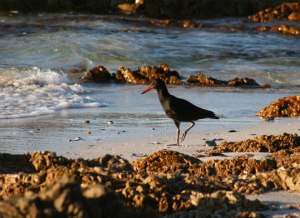The Oyster-catcher ( AFR: Swattobie) is one of those birds that cannot be confused with any of its neighbours, for its brilliant black plumage and red-orange beak, eyes and legs tell you immediately who they are.
The first oyster catcher I ever saw was a baby bird, not long out of its shell, but already able to toddle about. In fact, it toddled too far and had passed near a sitting tern so near that the tern was annoyed and savagely pecked the tiny youngster, sending it sprawling across the pebble rocks. Fortunately, the problem of what to do with this unfortunate little chap was soon solved for sweeping close to my face, a black bird angrily shrieked “kleep, kleep, kleep”. It was one of the parents. Very anxiously the parent bird flew down to take charge of its precious youngster, but whether it was the mother or father I did not know, for both sexes are much alike.
Since that day I was intrigued by these beautiful shore birds. They generally lay two eggs, so closely resembling the pebbles, that it takes the keenest of eyes to find them. The only nest an oystercatcher ever makes consists of a few shells collected together. Some oyster catchers do not even bother to do this and only make a saucer pan hollow in the sand so that the eggs cannot roll away.
This is also the reason for their declining numbers which made them end up on the Red Data list for Endangered Birds. In the eighties, there were less than 5000 (2000 breeding pairs) oyster-catchers left. Their numbers have increased dramatically after a law has been passed prohibiting 4×4 vehicles on the beach.
Having to sit on the eggs during hot weather must be a tiresome job, but they remain on duty hour after hour. Happily, both birds share the work Although married couples are very much in love with each other, it is not often that both are seen at the nest together. On several occasions, however, I have seen them change places on the eggs. Joyfully the going-off-duty bird then flies down to the sparkling waves.
When coming back to its eggs, the oyster-catcher takes great care not to show anybody where they are. Taking a zig-zag course, the cunning birds fly great distances out of its way, sometimes running and sometimes walking, rather than give away the secret of its nest. Indeed, the oyster-catcher will try to lead you away from its nest and many an anxious beachcomber followed the bird in hope of discovering its secret but after it has misled them a long way it gives a loud laugh and takes to wing.
Oystercatchers have an unusual migratory pattern that still baffles scientists. After losing their feathers the juvenile birds will fly all the way to Namibia and the south of Angola in search of a mate. This flight for some can be up to 3000 kilometres, the only migratory route of its kind in the world. Up north they will stay in colonies for 2 – 3 years before returning to our coasts.
The oystercatcher’s voice is shrill and high-pitched and its whistling call seems to come from different directions. It is a very vocal bird at all times. When a group of them comes together each seems to try screaming louder than its mates, a noisy piping chorus! Yet there is always something cheery and bright about oyster catchers, particularly when groups of them gather together on the surf and play the strange little games only they understand.
Even in winter, when the sky is grey and the sea is cold and foamy, oystercatchers are to be seen in crowds, bringing joy and happiness to those watching them.
Unlikely as it may seem,oyster-catchers eat limpets, mussels, cockles, periwinkles, worms and insects, in fact, anything but oysters. Mussels seem to be their favourite food.
Although Kogelberg in the greater Overberg area is not the home of the highest concentration of oystercatchers, they housed some unusual breeding pairs. A number of them laid three instead of the usual two eggs and two of the four known times that they have been breeding twice in one year, were also in the Overberg,
Fast facts about oystercatchers:
• Breed for life with one partner
• Lay only two eggs ( not both likely to hatch)
• One chick every 3 years
• Females are larger than males and also have longer beaks than males
• Migrate to Namibia after moulting
• Oldest known oyster-catcher male is 28 years. They might even live longer.

















